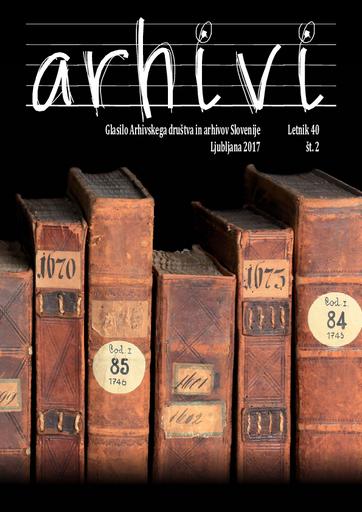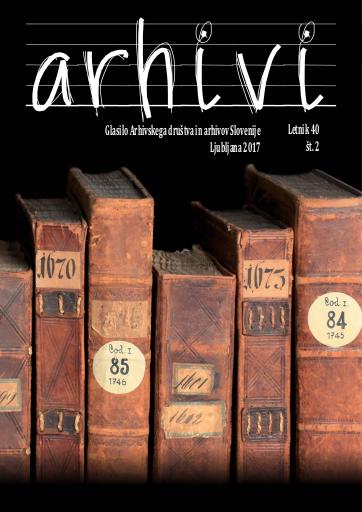/
Serijske publikacije
/
Arhivi
Samostani v Kopru v obdobju Beneške republike


To delo avtorja Zdenka Bonin je ponujeno pod Creative Commons Priznanje avtorstva-Nekomercialno-Deljenje pod enakimi pogoji 4.0 Mednarodna
Datoteke (1)

Opis
V Ankaranu, v neposredni bližini mesta, je že konec 12. stoletja nastal benediktinski samostan, na otoškem delu Kopra pa je med 13. in 18. stoletjem delovalo osem samostanov. Šest je bilo moških, dva pa ženska. Na začetku 13. stoletja je v predelu Zubenaga nastal dominikanski samostan, v drugi polovici stoletja pa v predelu Caprile samostan manjših bratov sv. Frančiška. V prvih desetletjih 14. stoletja sta nastala ženska samostana sv. Klare in sv. Blaža, v drugi polovici 15. stoletja pa so se v mesto naselili serviti, tretjeredniki in manjši bratje observanti. Po uničujoči kugi 1573 in 1578 so meščani v mesto povabili še kapucine, ki so samostan sv. Marte začeli graditi leta 1621.
Metapodatki (12)
- identifikatorhttps://hdl.handle.net/11686/41540
- naslov
- Samostani v Kopru v obdobju Beneške republike
- Monasteries in Koper during the Period of Venetian Republic
- avtor
- Zdenka Bonin
- soavtor
- Gregor Jenuš (gl. in odg. ur.)
- Dunja Mušič (teh. ur.)
- Petra Markuš (prev.)
- Tanja Martelanc (foto.)
- predmet
- ČLANKI IN RAZPRAVE
- Koper
- samostani
- dominikanci
- minoriti
- klarise
- avguštinke
- serviti
- tretjeredniki
- observanti
- kapucini
- ARTICLES AND PAPERS
- Koper
- monasteries
- Dominicans
- Minorites
- Poor Clares
- Augustinian nuns
- Servites
- tertiaries
- Observants, Capuchins
- opis
- Only a few decades after the formation of orders the town welcomed preaching friars and the Franciscans. When Absalon was the bishop, Dominicans settled in a part of Zubenag. The monastery founder was Hiacint, the pupil of Domenic de Guzman. By preaching, spreading the Gospel they left a special mark on the town, while they were also helping at the St. Nazarius hospital. In 1260 (Gedeone Pusterla and fra Ljudevit Maračić give the year 1230), friars minor came to Koper. St. Francis church was finally built in 1268, and also a monastery building alongside. The first decades of the 14th century saw the founding of two female monasteries. St. Clare’s convent was founded in 1301 and St. Blaise in 1318. In the 15th century, three more orders appeared in town. Servites were granted to build their own monastery in 1453 by the pope in a part of St. Martin where a smaller monastery and church already stood in honour of St Martin. Friars renewed the church and monastery and two years later gained the papal confirmation. Tertiaries who came from Dalmatia settled mid15th century in the area of Bošedraga. Cathedral chapter gave them a house and land where they later built St. Mary Magdalene church, while Francesco de Spelatis in 1467 left to fra Novak from Zadar the house and garden in Bošedraga (near St Andrew’s church) where later friars minor observants built their monastery. In 1492, husband and wife Almerigotti gifted Bernardin, vicar of Observants in Koper (church dedicated to the Blessed Virgin was in Bošedraga) the estate where they could build a new church. Orders exchanged a part of their estates in 1530. Observants gave St. Gregory’s church in Zubeneg to tertiaries for the church St. Magdalene in Bošedraga which stood beside their St. Anne’s monastery. In 1621, Capuchins started to build their monastery and three years later settled in the monastery and church dedicated to St. Martha and St. Mary Magdalene. The town boasted 6 male monasteries (Dominican, Minorite, Servite, Tertiary, Observant, and Capuchin) and two female monasteries (Ursulines and Augustine nuns) in the 17th century. Following the 1744 census (the town had 4,105 inhabitants), monasteries in Koper housed approx. 4.3 percent of the entire town population. A significant turning point in the manner of operation of church institutions was the French occupation of Istria. On the basis of decrees from 8 June 1805, and from 24 and 30 March 1806, the French dissolved the majority of church societies, while their assets were joined with the ones of the state. The document of 19 September 1806 clearly shows 8 monasteries (Minorite and Dominican monasteries in Koper, Minorite monasteries in Piran, Pula, Vodnjan, Muggia, and Poreč, and Dominican hospice in Poreč) and 2 convents (St. Blaise monastery and St. Clare monastery in Koper) were operating in Istria. Income from monasteries amounted to about 15.713 Milan lire, both convents brought 23.933 Milan lire. After the dissolution of the majority of monasteries, Slovene Istria was left with only Minorite monastery in Piran (joined by dissolved monasteries from Koper, Muggia, and Poreč), St. Lazarus monastery in Izola, Capuchin monastery of St. Martha in Koper (joined by suppressed the Holy Trinity monastery in Palmanova and hospice in Vodnjan), Observant monastery in Koper (joined by St. Bernardine’s monastery in Piran), St. Blaise monastery of Augustinian nuns (joined by St. Clare monastery), and College in Koper.
- založnik
- Arhivsko društvo Slovenije
- datum
- 2017
- 01. 01. 2017
- tip
- besedilo
- jezik
- Slovenščina
- jeDelOd
- pravice
- licenca: ccByNcSa
